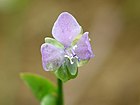Note: This is a project under development. The articles on this wiki are just being initiated and broadly incomplete. You can Help creating new pages.
Difference between revisions of "Murdannia nudiflora"
(→Uses) |
|||
| (One intermediate revision by the same user not shown) | |||
| Line 2: | Line 2: | ||
'''Murdannia nudiflora''' is a genus of annual or perennial monocotyledonous flowering plants in the day flower family. | '''Murdannia nudiflora''' is a genus of annual or perennial monocotyledonous flowering plants in the day flower family. | ||
==Uses== | ==Uses== | ||
| − | {{Uses|Asthma}}, {{Uses|Leprosy}}, {{Uses|Piles | + | {{Uses|Asthma}}, {{Uses|Leprosy}}, {{Uses|Piles}} {{Uses|Stomach complaints}}, {{Uses|Giddiness}},{{Uses|astringent}}. |
==Parts Used== | ==Parts Used== | ||
Latest revision as of 17:35, 24 June 2020
Murdannia nudiflora is a genus of annual or perennial monocotyledonous flowering plants in the day flower family.
Contents
- 1 Uses
- 2 Parts Used
- 3 Chemical Composition
- 4 Common names
- 5 Properties
- 6 Habit
- 7 Identification
- 8 List of Ayurvedic medicine in which the herb is used
- 9 Where to get the saplings
- 10 Mode of Propagation
- 11 How to plant/cultivate
- 12 Commonly seen growing in areas
- 13 Photo Gallery
- 14 References
- 15 External Links
Uses
Asthma, Leprosy, Piles Stomach complaints, Giddiness,astringent.
Parts Used
Chemical Composition
Murdannia nudiflora ranges from 96.825% to 82.539%, while that of Tradescantia pallida ranges from 95.238% to 84.127% and that of ascorbic acid ranges from 96.825% to 87.302%. [1]
Common names
| Language | Common name |
|---|---|
| Kannada | |
| Hindi | Kansura |
| Malayalam | Tali-pullu |
| Tamil | |
| Telugu | |
| Marathi | NA |
| Gujarathi | NA |
| Punjabi | NA |
| Kashmiri | NA |
| Sanskrit | |
| English | Doveweed, Malabar Dewflower |
Properties
Reference: Dravya - Substance, Rasa - Taste, Guna - Qualities, Veerya - Potency, Vipaka - Post-digesion effect, Karma - Pharmacological activity, Prabhava - Therepeutics.
Dravya
Rasa
Guna
Veerya
Vipaka
Karma
Prabhava
Habit
Identification
Leaf
| Kind | Shape | Feature |
|---|---|---|
| Simple | Linear in outline | 2-10 cm long, 2-5 mm wide. Leaf sheaths have soft hairs on the upper margins. Stems are not readily evident, but upon closer examination, stems can be seen close to the ground and rooting at the nodes. |
Flower
| Type | Size | Color and composition | Stamen | More information |
|---|---|---|---|---|
| Bisexual | Ovel shape | Blue to purple in color | Flowers are blue to purple in color with petals that are 5 to 8 mm long |
Other features
List of Ayurvedic medicine in which the herb is used
Where to get the saplings
Mode of Propagation
How to plant/cultivate
Lowland irrigated, rainfed and upland rice fields. Sunny to rather deeply shaded, not too dry sites; in teak forest, tea and cinchona plantation, arable land and gardens, edges of water, ruderal sites. Often very common.[3]
Commonly seen growing in areas
Photo Gallery
References
External Links
- Ayurvedic Herbs known to be helpful to treat Asthma
- Ayurvedic Herbs known to be helpful to treat Leprosy
- Ayurvedic Herbs known to be helpful to treat Piles
- Ayurvedic Herbs known to be helpful to treat Stomach complaints
- Ayurvedic Herbs known to be helpful to treat Giddiness
- Ayurvedic Herbs known to be helpful to treat astringent
- Herbs with Roots used in medicine
- Herbs with Leaves used in medicine
- Herbs with common name in Hindi
- Herbs with common name in Malayalam
- Herbs with common name in English
- Habit - Herbs
- Index of Plants which can be propagated by Seeds
- Herbs that are commonly seen in the region of Lowland forest
- Herbs
- Commelinaceae



